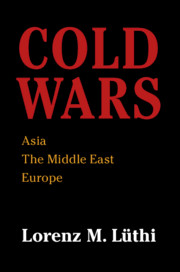Book contents
- Cold Wars
- Cold Wars
- Copyright page
- Dedication
- Contents
- Maps
- Acknowledgments
- Note on Names, Transliterations, and References
- Abbreviations
- Introduction
- 1 From High Imperialism to Cold War Division
- Part I Elusive Unities
- Part II Asia
- Part III The Middle East
- Part IV Alternative World Visions
- Introduction to Chapters 11 to 13
- 11 Asian–African Internationalism
- 12 Non-Alignment
- 13 Pan-Islamism
- Part V Europe between the Superpowers
- Part VI European Détente
- Part VII The End of the Regional Cold Wars
- Notes
- Index
12 - Non-Alignment
from Part IV - Alternative World Visions
Published online by Cambridge University Press: 19 March 2020
- Cold Wars
- Cold Wars
- Copyright page
- Dedication
- Contents
- Maps
- Acknowledgments
- Note on Names, Transliterations, and References
- Abbreviations
- Introduction
- 1 From High Imperialism to Cold War Division
- Part I Elusive Unities
- Part II Asia
- Part III The Middle East
- Part IV Alternative World Visions
- Introduction to Chapters 11 to 13
- 11 Asian–African Internationalism
- 12 Non-Alignment
- 13 Pan-Islamism
- Part V Europe between the Superpowers
- Part VI European Détente
- Part VII The End of the Regional Cold Wars
- Notes
- Index
Summary
Non-Alignment also was a creation of India’s Jawaharlal Nehru, though Yugoslavia’s Josip Broz Tito and Egypt’s Gamal Abdel Nasser established the movement of bloc-free status in the Cold War, by 1961. Unlike Asian-African Internationalism, Non-Alignment attracted a large number of sub-Saharan African states. In 1961-1965, Non-Alignment developed into the antagonist of Asian-African internationalism, particularly in the context of China’s radicalized policies towards the Afro-Asian world. But victory in this struggle still left Non-Alignment deeply shaken. The June War in 1967 between Israel and its Arab neighbors further taxed the movement’s internal unity and political raison d’être, since the founding member Egypt was one of the belligerents in a conflict in which the superpower blocs lined up behind the two warring sides. The Soviet-led intervention in Czechoslovakia the following year forced Tito to pull back from instituting Non-Aligned collaboration with the Socialist Camp. Yet, against the background of the ongoing Indochina conflict, Non-Alignment still sided increasingly with the Socialist Camp in the first half of the 1970s, undermining its own purpose in the long term.
- Type
- Chapter
- Information
- Cold WarsAsia, the Middle East, Europe, pp. 287 - 306Publisher: Cambridge University PressPrint publication year: 2020

